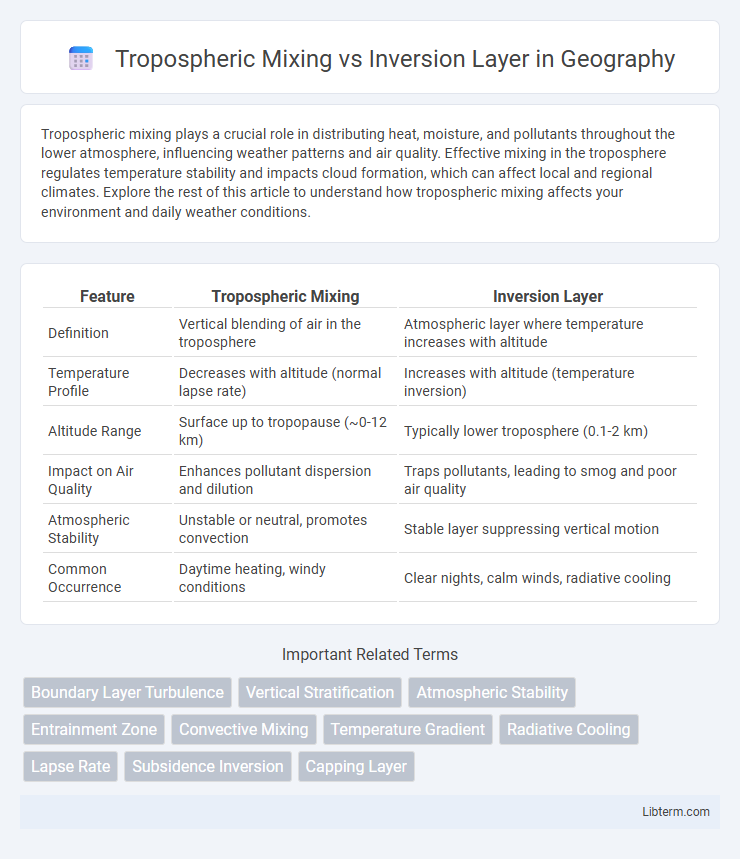Tropospheric mixing plays a crucial role in distributing heat, moisture, and pollutants throughout the lower atmosphere, influencing weather patterns and air quality. Effective mixing in the troposphere regulates temperature stability and impacts cloud formation, which can affect local and regional climates. Explore the rest of this article to understand how tropospheric mixing affects your environment and daily weather conditions.
Table of Comparison
| Feature | Tropospheric Mixing | Inversion Layer |
|---|---|---|
| Definition | Vertical blending of air in the troposphere | Atmospheric layer where temperature increases with altitude |
| Temperature Profile | Decreases with altitude (normal lapse rate) | Increases with altitude (temperature inversion) |
| Altitude Range | Surface up to tropopause (~0-12 km) | Typically lower troposphere (0.1-2 km) |
| Impact on Air Quality | Enhances pollutant dispersion and dilution | Traps pollutants, leading to smog and poor air quality |
| Atmospheric Stability | Unstable or neutral, promotes convection | Stable layer suppressing vertical motion |
| Common Occurrence | Daytime heating, windy conditions | Clear nights, calm winds, radiative cooling |
Introduction to Tropospheric Mixing
Tropospheric mixing refers to the vertical and horizontal movement of air within the troposphere, which plays a crucial role in distributing heat, moisture, and pollutants. This process is driven primarily by convection, wind shear, and atmospheric turbulence, enhancing air quality and weather patterns. In contrast, an inversion layer acts as a stable atmospheric boundary that suppresses vertical mixing by trapping cooler air beneath warmer air, often leading to pollution accumulation and poor dispersion.
What is an Inversion Layer?
An inversion layer is a meteorological phenomenon where a layer of warm air traps cooler air near the Earth's surface, preventing normal vertical mixing in the troposphere. This stable atmospheric condition inhibits the dispersion of pollutants, leading to increased air pollution and smog concentrations. In contrast, tropospheric mixing promotes vertical movement of air, enhancing pollutant dilution and improving air quality.
Key Differences: Tropospheric Mixing vs Inversion Layers
Tropospheric mixing occurs when warm air near the surface rises and cool air descends, promoting the vertical exchange of atmospheric gases and pollutants within the troposphere. Inversion layers form when a warm air layer overlies cooler air near the surface, creating a stable stratification that inhibits vertical air movement and traps pollutants close to the ground. These key differences impact air quality and weather patterns, with mixing enhancing dispersion and inversion layers often leading to pollution buildup and temperature stability.
Physical Processes Behind Tropospheric Mixing
Tropospheric mixing is primarily driven by turbulent convection and mechanical turbulence caused by wind shear, which facilitate the vertical exchange of air masses and the redistribution of heat, moisture, and pollutants within the troposphere. In contrast, the inversion layer acts as a thermally stable boundary where temperature increases with altitude, suppressing vertical air movement and limiting the extent of mixing below this layer. The interplay between solar radiation-induced surface heating and radiative cooling at upper levels establishes temperature gradients that govern the intensity and depth of tropospheric mixing processes.
Formation and Causes of Inversion Layers
Inversion layers form when a layer of warm air traps cooler air beneath it, preventing vertical mixing in the troposphere and leading to stable atmospheric conditions. These temperature inversions commonly arise during clear nights due to radiative cooling of the Earth's surface or when warm air masses override cooler surface air, often facilitated by high-pressure systems. The suppression of vertical tropospheric mixing by inversion layers results in accumulated pollutants and reduced air quality near the ground.
Impact on Weather and Local Climate
Tropospheric mixing enhances vertical air movement, promoting the dispersion of heat, moisture, and pollutants, which stabilizes local weather patterns and supports cloud formation. In contrast, an inversion layer creates a temperature barrier that traps pollutants and moisture near the surface, often leading to stagnant air conditions, fog, and smog. This temperature inversion suppresses convection, resulting in prolonged periods of poor air quality and altered local climate dynamics.
Effects on Air Quality and Pollution Dispersion
Tropospheric mixing enhances the vertical exchange of air, promoting the dispersion of pollutants and improving air quality by diluting concentrations near the surface. Inversion layers create stable atmospheric conditions that trap pollutants close to the ground, leading to elevated concentrations and degraded air quality due to limited vertical mixing. The presence and intensity of inversion layers directly affect the severity of air pollution episodes in urban and industrial regions by restricting the natural dispersion processes.
Tropospheric Mixing in Atmospheric Stability
Tropospheric mixing enhances atmospheric stability by promoting vertical movement of air masses, which helps to disperse pollutants and regulate temperature gradients. This process counteracts the formation of an inversion layer, where a stable layer traps cooler air beneath warmer air, inhibiting vertical mixing. Understanding tropospheric mixing dynamics is crucial for predicting weather patterns and air quality in the lower atmosphere.
Inversion Layers and Their Role in Extreme Weather
Inversion layers occur when a stable layer of warm air traps cooler air beneath it, inhibiting tropospheric mixing and leading to stagnation of pollutants and moisture. This phenomenon intensifies extreme weather events such as heatwaves, fog, and heavy smog by preventing vertical air movement and trapping heat near the surface. Understanding inversion layers is critical for forecasting air quality issues and predicting the severity of temperature extremes in urban and mountainous regions.
Implications for Environmental Monitoring and Forecasting
Tropospheric mixing enhances the dispersion of pollutants, improving air quality predictions and facilitating more accurate environmental monitoring by reducing localized contaminant concentrations. In contrast, inversion layers trap pollutants close to the ground, leading to increased pollution levels and presenting significant challenges for forecasting air quality and assessing health risks. Understanding the dynamics between tropospheric mixing and inversion layers is crucial for developing reliable atmospheric models and implementing effective pollution control strategies.
Tropospheric Mixing Infographic

 libterm.com
libterm.com